
Introduction
The Port of Vancouver extends from the U.S. border to Point Atkinson. All waters of Boundary Bay, the approaches to the Fraser River and Burrard Inlet are included as Port Jurisdiction.
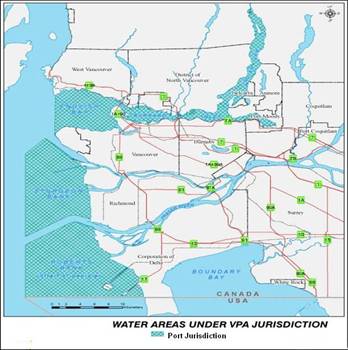
The main focus of this project will deal with Burrard Inlet. The inlet poses a large risk for a major oil spill. Large amounts of oil and gas are shipped through the Vancouver Port. From the table below we see that about 3000 metric tones of hydrocarbons are transported through the port on a yearly basis. Other potential risks are from the major refineries, anchorages for large ocean vessels, large docks and refilling facilities.
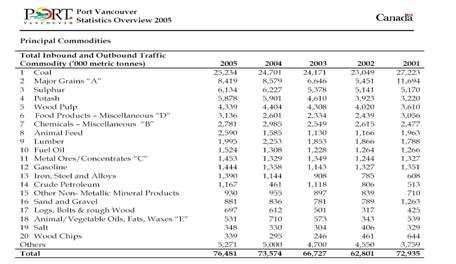
Oil spills can cause large scale environmental damage due to the characteristics of oil. Crude oil is made up of complex hydrocarbon compounds that range from light gasses to heavier tars and waxes. Oil is composed of thousands of compounds in varying quantities. No two crude oils are exactly alike because of the many different compositions. The different physical and chemical properties of crude and refined oils are very important - they influence the physical and biological effects of an oil spill, the behavior of a slick and the effectiveness of clean-up operations. Some oils are far more harmful to the environment and more toxic than others. There are a number of ways in which oil is released into the environment. An accidental spill is only one of several ways that oil ends up in the water. Naturally-occurring oil seeps, offshore oil and gas production, marine transportation, waste discharges and runoff are other ways. The two major sources of oil input into the environment are municipal waste and routine tanker operations such as bilge washing
Effects of an Oil Spill In Burrard Inlet
If a major oil spill occurred in Burrard Inlet it would impact on the biological, socioeconomic and physical resources.
Biological Resources
Birds: The Burrard Inlet area is a significant site for migratory birds along the coast. Birds are usually most noticeable casualties of oil spills. Birds that are most vulnerable to oil would be the diving ducks, loons, grabes and cormorants.

Mammals: The Burrard Inlet is an important concentration area for harbor seals, California and steller’s sea lions and killer whales. Most of the activity of these mammalians is at the water surface. Hence, they are prone to oiling.
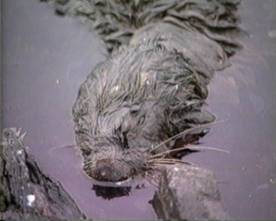
Fish and Shellfish: Fish may ingest large amounts of oil through their gills. Fish that have been exposed to oil may suffer from changes in heart and respiratory rate, reduced growth, fin erosion and a variety of effects at biochemical and cellular levels. If this does not kill them more or less directly, the oil may affect the reproductive capacity negatively and result in deformed fry. Very little is also known about the effects of oil on shellfish except for the fact that contamination with hydrocarbons will make shellfish taste and smell bad and thus make it impossible to use them for food. The area of Burrard Inlet is closed for shellfish harvesting as well as commercial fishing, hence it does not pose a risk to human health.
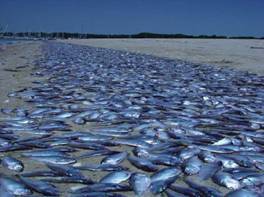
Socio-Economic Resources/ Physical Sensitivity
The Port of Vancouver is famous for its beaches, foreshore parks, recreational waterways and natural areas. Business and industrial use of the shoreline and waterways is an equally important feature. An oil spill could bring a halt to industrial as well as recreational activities. Knowledge of the shoreline types will help in formulating clean up methods and techniques to use during a response.
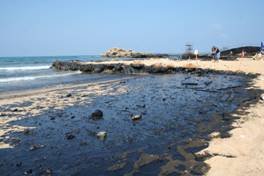

Locating Oil Spill Response Equipment around Burrard Inlet
Since a large oil spill poses such a large risk in Burrard Inlet it is very important to be prepared. Since we cannot prevent all oil spills, we have to be ready to respond quickly when they do occur. To respond to large oil spills a number of things can be done to minimize impact to the environment which are as follows: use of contingency plan, training, oil spill exercises, equipment depots and Co-ops, protecting sensitive areas.
This project mainly focuses on one aspect of oil spill response and that is locating stock piles of equipment around potential risk sites. There are a number of different types of equipment to deal with oil spills. There are mainly two types of clean up equipment. One type is on water operation equipment and the other type is shoreline clean up equipment.
On Water Response Equipment: Once oil is released into the marine environment, it is very important to deal with this oil first. This is because shoreline clean up operation cannot be carried out if there is on-water oil as it would cause re-oiling of the beaches. The usual equipment used to combat this is: containment booms, on-water skimmers, role pads, vacuum systems, dispersant etc
.

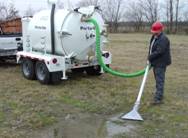

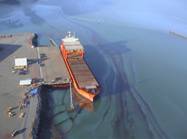
Shoreline Clean up Equipment: Once the on-water clean up operations are over and all the oil has been recovered from the water, the focus of clean up operations switch to the shoreline cleanup. Oil can impact the shoreline depending on the type of shoreline. Knowing the shoreline type and oil product is very important because the techniques used for clean up depend on it. Large amounts of equipment and man power are needed for these types of operations. Equipment such as oil absorbent pads, sock booms, water pumps, protective gear, shoreline cleaner (dispersant), pom-poms etc are used for this type of operation.


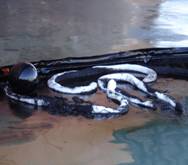
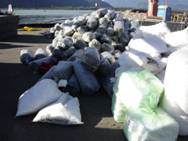
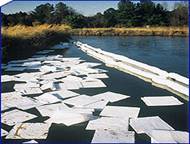
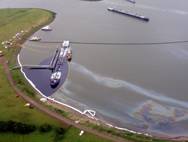
Locating such type of equipment is key in Burrard Inlet. This project deals mainly with locating oil spill response equipment in an event of a large spill. A number of factors come into play when locating oil spill equipment. The analysis for this project deals with factors like access points (boat launch locations, air craft landing sites), Land use (Industrial and Commercial), road access, potential risk sites (sites where oil spills could occur). It also deals with locations that are constraints in locating such equipment (first Nation Land)..